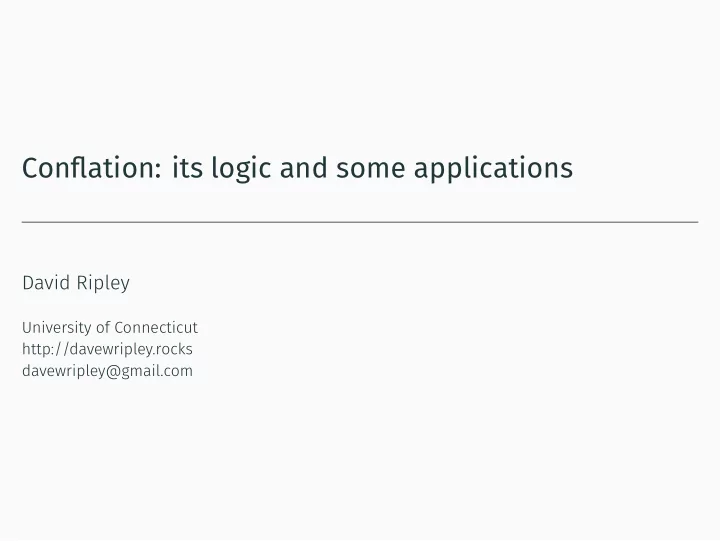

Conflation: its logic and some applications David Ripley University of Connecticut http://davewripley.rocks davewripley@gmail.com
Conflation
Conflation slenderness substance dualism • y xR x y , and x yR x y • and reading/revealing emails, tampering with votes • and health, • What is it? and weight, mass • and relativistic mass, proper mass • and another ant, one ant • eg: We conflate when we treat multiple things as one. and property dualism.
Conflation What is it? substance dualism • • and reading/revealing emails, tampering with votes • and health, slenderness • and weight, mass • and relativistic mass, proper mass • and another ant, one ant • eg: We conflate when we treat multiple things as one. and property dualism. ∀ x ∃ yR ( x , y ) and ∃ y ∀ xR ( x , y ) ,
Conflation Why care? Getting clear on conflation can help us both popular and academic. And it turns out to shed light on some longstanding philosophical problems. see the value of distinctions. It can help us diagnose misunderstandings,
The logic of conflation
The logic of conflation A logic of conflation? Really? Sometimes people say logic can only apply after all conflations have been removed. This needlessly hamstrings logic: unrecognized conflations are likely to be rampant, and some distinctions are not worth drawing.
The logic of conflation Well, why not? I’m interested in logical theories of the social norms that constitute the meanings of our words. When I write Γ ⊢ ∆ , this means it is out of bounds to assert everything in Γ and deny everything in ∆ . This is a kind of validity. Vocabulary meanings are given in terms of conditions on ⊢ .
is to assert both A and B . The logic of conflation iff both A and B are. Example: conjunction ∧ A , B , Γ ⊢ ∆ Γ ⊢ ∆ , A Γ ⊢ ∆ , B A ∧ B , Γ ⊢ ∆ Γ ⊢ ∆ , A ∧ B The left rule: to assert A ∧ B The right rule: A ∧ B is undeniable
iff both A and B are. The logic of conflation is to deny both A and B . Example: disjunction ∨ A , Γ ⊢ ∆ B , Γ ⊢ ∆ Γ ⊢ ∆ , A , B A ∨ B , Γ ⊢ ∆ Γ ⊢ ∆ , A ∨ B The left rule: A ∨ B is unassertible The right rule: to deny A ∨ B
The logic of conflation Three theses Thesis zero: All conflation results in propositional conflation. Thesis one: It is distinctions that undermine validity, Thesis two: If conflation affects the validity of an argument, it must be that some conflation occurs in the argument. not conflations.
The logic of conflation The funk-based approach Here are the rules for the connective funk (so dubbed by Teijeiro): It is the conflation of A and B . A , B , Γ ⊢ ∆ Γ ⊢ ∆ , A , B A ⊗ B , Γ ⊢ ∆ Γ ⊢ ∆ , A ⊗ B A ⊗ B has the assertability conditions of A ∧ B and the deniability conditions of A ∨ B .
Two applications
Two applications Vagueness The conflation theory of vagueness: Vague predicates express the conflation of their precisifications. So ‘tall’ expresses ( ≥ 169cm ) ⊗ ( ≥ 170cm ) ⊗ . . . .
Two applications Vagueness The conflation theory explains tolerance: —SO— It diagnoses the sorites argument as equivocation. Each step is valid, but they cannot be chained together. Alice is ≥ 170cm tall, Alice is within 1cm in height of Zebra ⊢ Zebra is ≥ 169cm tall Alice is tall, Alice is within 1cm in height of Zebra ⊢ Zebra is tall
Two applications Vagueness The conflation theory explains borderline contradictions: Alice is exactly 169cm tall —SO— ⊢ Alice is ≥ 169cm tall and not ≥ 170cm tall Alice is exactly 169cm tall ⊢ Alice is tall and not tall
Two applications Slurs The conflation theory of slurs Slurs express the conflation of group membership with group-membership-and-X, where X is ‘despicable because of it’, a more specific stereotype, recommended treatment, etc. So ‘boche’ expresses German ⊗ (German ∧ cruel ∧ . . . )
Two applications Slurs According to Dummett, what matters is permissible inference. One may infer ‘A is boche’ from ‘A is German’, and infer ‘A is cruel’ from ‘A is boche’. But surely one can infer ‘A is German’ too!
Two applications Slurs According to Hom, ‘boche’ expresses something like ‘ought to be discriminated against because of being cruel, all because of being German’ But this falsely predicts that ‘A is not a boche’ should not slur Germans, and should be compatible with A being German.
Two applications Slurs The conflation theory avoids Dummett’s problem: and it does not care about direction of inference. And it avoids Hom’s problem: and still conflates German with German and cruel. the conflation is not between German and cruel, but between German and German and cruel, to deny that A is boche requires denial that A is German,
Summary
Summary • Conflation is a wide-ranging phenomenon. • We can understand it through funk: • The conflation theory of vagueness explains tolerance, and diagnoses the sorites as equivocation. • The conflation theory of slurs fixes problems with Dummett’s and Hom’s semantic theories. conflations are assertible when related conjunctions are, and deniable when related disjunctions are.
Recommend
More recommend